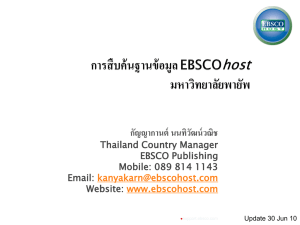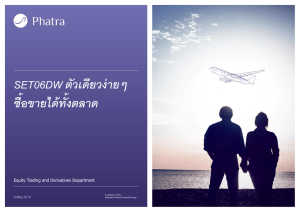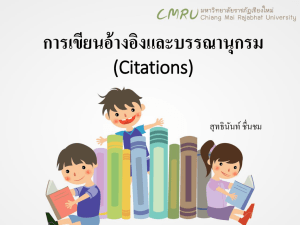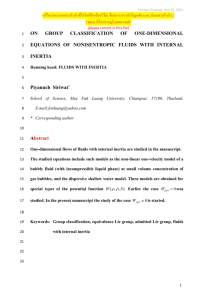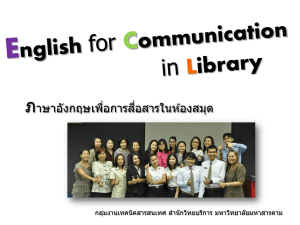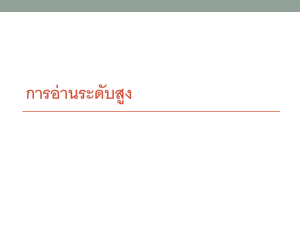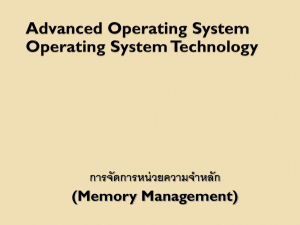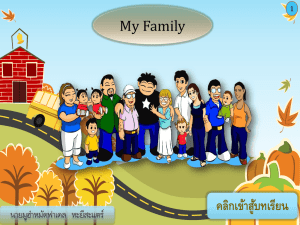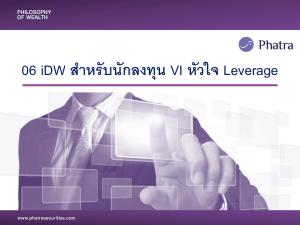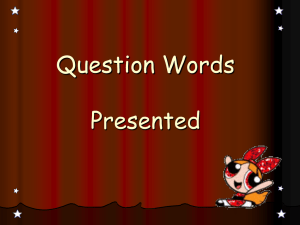อิทธิพลของสารสนเทศที่มีต่อผู้เรียน
advertisement
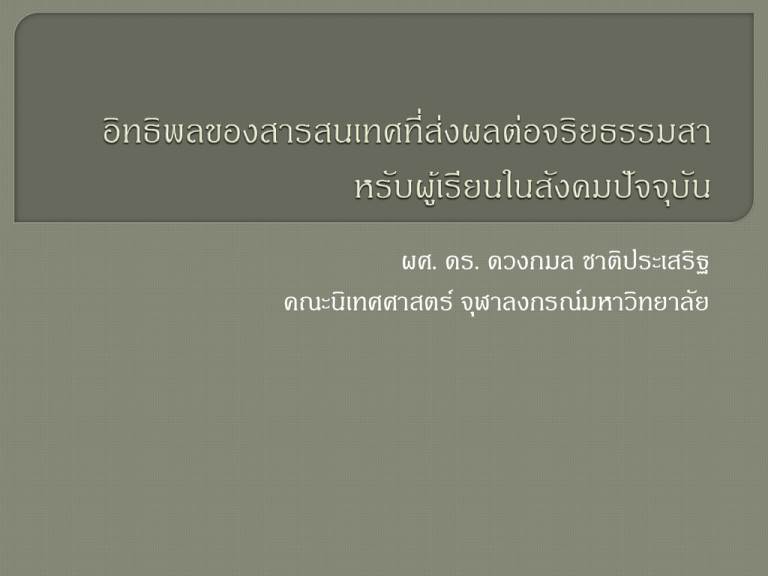
ผศ. ดร. ดวงกมล ชาติประเสริฐ คณะนิเทศศาสตร์ จุฬาลงกรณ์มหาวิทยาลัย Information obtained from the web, may be viewed as ‘free’ and thus not necessitating the usual academic documentation or citation A simple ‘cut and paste’ from a web-site, may be viewed as providing evidence of ‘like-minded’ thinkers. Since these opinions are found on the web, students may accept that such work is not officially ‘published’ (like articles that appear in scholarly academic journals) and thus do not require academic references students may interpret information gathered through web-sites as legitimate’ sources of data, and thus opt to incorporate such findings into their work. The most recent National Survey of Student Engagement indicates that as high as 59% of U.S. students involved in eLearning programs admit to some sort of academic fraud either “very often (27%) or “often” (32%). (NSSE, 2007) ผูต ้ อบแบบสอบถามกว่าร้อยละ 70 ระบุว่าเคยคัดลอกและดัดแปลง ข้อความจากอินเทอร์เน็ ต หรือเคยนาข้อมูลจากอินเทอร์เน็ ตมาใช้โดย ไม่เขียนอ้างอิงแหล่งที่มาในระดับตั้งแต่ปานกลางขึ้ นไป ในจานวนนี้ เกือบร้อยละ 40 ระบุว่าเคยละเมิดจริยธรรมในแต่ละด้านในระดับ มากขึ้ นไป การละเมิดที่พบว่ามีผูท ้ าสูงสุดคือการดัดแปลงข้อมูลจากอินเทอร์เน็ ต มาเป็ นของตนเอง และการไม่ เ ขี ย นอ้า งอิ ง แหล่ ง ที่ ม าเนื่ อ งจากไม่ ปรากฏแหล่งที่ มาอยู่แล้ว และเนื่ องจากเป็ นเรื่องยุ่งยาก ส่ วนผูท้ ี่ ไม่ เขียนอ้างอิงแหล่งที่มาเนื่ องจากไม่อยากให้ใครรูว้ า่ คัดลอกมามีจานวน น้อยกว่าการไม่อา้ งอิงแหล่งที่มาเพราะสองสาเหตุขา้ งต้น ได้รบ ั คาแนะนาจากอาจารย์ให้เห็นความสาคัญของการอ้างอิง หากไม่อา้ งอิงเกรงว่าจะถูกอาจารย์ตด ั คะแนน เห็นความสาคัญของการอ้างอิงด้วยตนเอง แม้จะอ้างอิงแหล่งที่มาก็ไม่ได้เห็นความสาคัญ แต่ทาไปเพื่อให้ ครบถ้วนตามรูปแบบของการทารายงานเท่านั้น อ้างอิงเพราะทาให้ขอ ้ มูลมีความน่ าเชื่อถือ มิใช่อา้ งอิงเพราะเหตุผล ทางจริยธรรม ไม่เห็นความสาคัญ ไม่ได้อา้ งอิงเนื่ องจากมีเจตนาที่จะใช้อินเทอร์เน็ ตเพื่อคัดลอกงาน เข้าใจว่าเนื้ อหาที่เผยแพร่บนอินเทอร์เน็ ตเป็ นเนื้ อหาที่เปิ ดเผยให้ สาธารณชนได้ใช้ จึงไม่จาเป็ นต้องอ้างอิง การทางานส่งอาจารย์ไม่จาเป็ นต้องอ้างอิงเนื่ องจากไม่ได้เผยแพร่ในวง กว้าง นาข้อมูลจากหลายแหล่งมาประมวลกัน และใส่ความคิดเห็นหรือการ วิเคราะห์ของตนลงไปด้วย ถ้าในลักษณะนี้ ตนไม่คิดว่าเป็ นการละเมิด ลิขสิทธิ์ และอาจารย์ถือว่าเป็ นการสังเคราะห์ดว้ ยตัวผูเ้ รียนเอง Inappropriate assistance on examinations Misuse of sources on papers and projects Writing assistance and other inappropriate tutoring Misrepresentation reporting of data in the collection and Fass, R. A. (1990) Cheating and plagiarism. Ethics and Higher Education. May, W. W. editor. New York: Macmillan Publishing Company and American Council on Education . Improper use of academic resources Disrespecting Lack the work of others of protection for human subjects in research Breaches Lack of computer ethics of adherence to copyright and copy- protection Ethics of examinations Use of sources on papers and projects Writing assistance and other tutoring Collecting and reporting data Use of academic resources Respecting the work of others Computer ethics Giving assistance to others Adherence to academic regulations Providing Lack inappropriate assistance to others of adherence to academic regulations pressure anxiety lack for grades in the testing environment, of knowledge related to academic regulations, personality lack characteristics of development of moral reasoning. Technology has given cheaters and people with low ethical standards more options for dishonesty. Via the Internet, one can buy term papers, look for old tests and answers, and even find someone to act as an impersonator throughout an entire course. Psychological Lack distance of knowledge of curricular regulations and the academic code of behavior เนื้ อหาของสารสนเทศ รูปแบบของสารสนเทศ ลักษณะของเทคโนโลยีสารสนเทศที่ใช้สาหรับ e learning Social Cognitve Theory (Bandura) พฤติ ก รรมของคนเราส่ ว นมากจะเป็ นการเรี ย นรู ้โ ดยการสั ง เกต (Observational Learning) หรือการเลียนแบบจากตัวแบบ (Modeling) สาหรับตัวแบบไม่จาเป็ นต้องเป็ นตัวแบบที่มีชี วิตเท่านั้น แต่ อ าจจะเป็ นตัว สัญ ลัก ษณ์ เช่ น ตัว แบบที่ เ ห็ น ในโทรทัศ น์ หรื อ ภาพยนตร์หรืออาจจะเป็ นรูปภาพการ์ตนู หนังสือคาบอกเล่าด้วยคาพูด หรือข้อมูลที่เขียนเป็ นลายลักษณ์อกั ษรก็เป็ นตัวแบบได้ มีแรงเสริมให้ได้สิ่งที่ตอ ้ งการ และไม่ตอ้ งเจอสิ่งที่ไม่ตอ้ งการ ไม่มีการลงโทษ สื่อสามารถเป็ นได้ท้งั ต้นแบบ และเสนอเนื้ อหาที่มีผลต่อแรงจูงใจ เจตนาที่จะแสดงพฤติกรรมเป็ นผลจาก •ทัศนคติต่อพฤติกรรม •อิทธิพลของกลุ่มอ้างอิง •การรับรูก้ ารควบคุมพฤติกรรม สิ่งที่เป็ นธรรมชาติ ต้องยอมรับ หลีกเลี่ยงไม่ได้ ให้คุณค่าแก่ความสาเร็จในระบบทุนนิ ยม มีปริมาณมาก มีความซับซ้อน เขียนด้วยภาษาต่างประเทศ มีการคัดลอกต่อ ๆ กันมา หาที่มาไม่ได้ มีการนาเสนอที่ดไู ม่เป็ นทางการ ข้อมูลเมื่ออยูบ ่ นอินเทอร์เน็ ตจะสืบค้นได้งา่ ย ข้อมูลถูกคัดลอกและดัดแปลงได้งา่ ย ความไม่มีตวั ตน ความสัมพันธ์ระหว่างผูส ้ อนและผูเ้ รียน • • • • ความเคารพ การประเมินความสามารถ การสื่อสารผ่านคอมพิวเตอร์ ทาให้เกิด psychological distance Disinhibitory effect In interacting with others face-to-face we get immediate feedback on inappropriate and unethical behaviors, even if it is as subtle as body language. In using information technology in a way that could harm to others, the act feels less personal because we can’t see or hear the other person in the exchange.
